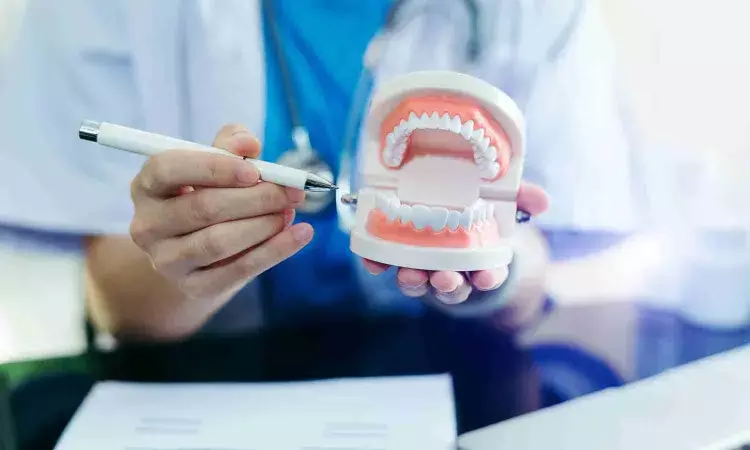- Home
- Medical news & Guidelines
- Anesthesiology
- Cardiology and CTVS
- Critical Care
- Dentistry
- Dermatology
- Diabetes and Endocrinology
- ENT
- Gastroenterology
- Medicine
- Nephrology
- Neurology
- Obstretics-Gynaecology
- Oncology
- Ophthalmology
- Orthopaedics
- Pediatrics-Neonatology
- Psychiatry
- Pulmonology
- Radiology
- Surgery
- Urology
- Laboratory Medicine
- Diet
- Nursing
- Paramedical
- Physiotherapy
- Health news
- Fact Check
- Bone Health Fact Check
- Brain Health Fact Check
- Cancer Related Fact Check
- Child Care Fact Check
- Dental and oral health fact check
- Diabetes and metabolic health fact check
- Diet and Nutrition Fact Check
- Eye and ENT Care Fact Check
- Fitness fact check
- Gut health fact check
- Heart health fact check
- Kidney health fact check
- Medical education fact check
- Men's health fact check
- Respiratory fact check
- Skin and hair care fact check
- Vaccine and Immunization fact check
- Women's health fact check
- AYUSH
- State News
- Andaman and Nicobar Islands
- Andhra Pradesh
- Arunachal Pradesh
- Assam
- Bihar
- Chandigarh
- Chattisgarh
- Dadra and Nagar Haveli
- Daman and Diu
- Delhi
- Goa
- Gujarat
- Haryana
- Himachal Pradesh
- Jammu & Kashmir
- Jharkhand
- Karnataka
- Kerala
- Ladakh
- Lakshadweep
- Madhya Pradesh
- Maharashtra
- Manipur
- Meghalaya
- Mizoram
- Nagaland
- Odisha
- Puducherry
- Punjab
- Rajasthan
- Sikkim
- Tamil Nadu
- Telangana
- Tripura
- Uttar Pradesh
- Uttrakhand
- West Bengal
- Medical Education
- Industry
Students using virtual reality simulators had better tooth preparation angles: BMC

A new study published in the journal of BMC Oral Health showed that comparing students who utilized virtual reality simulators to those who did not, the former performed better in terms of tooth preparation angles.
It has been suggested that dental students' preparation abilities may not be sufficiently developed by preclinical instruction. As technology advances, computer-aided simulations are being used more often in dentistry education. Though it's yet uncertain if these characteristics result in faster or better skill learning, virtual reality (VR) patient simulators offer practice in a realistic setting with frequent, detailed, and objective feedback. This study is to find out how virtual reality simulations affect students' clinical readiness.
The exocad® DentalCAD program, a CAD software, was used in this study to measure TOC (Total Occlusal Convergence) angles from the tooth preparation data of 100 fourth-year students who practiced preparation using a virtual reality device and had real patient experience, as well as a group of 100 fifth-year students who had no prior virtual reality experience but had real patient experience.
The SPSS software was used to examine the data gathered from these measurements. To compare various experience contexts, 25 randomly selected participants from each group were prepared in a phantom model in addition to this study. Thus, to assess the students' opinions of this novel training approach, a questionnaire was lastly given to the group that had received simulator instruction.
According to the descriptive statistical study, 4th-year students' average preparation angles were lower than that of 5th-year students. Thus, it is feasible to conclude that grade levels have a statistically significant impact on all surface preparation outcomes.
The average preparation angles taken based on the tooth surfaces of the 4th and 5th grades are as follows, according to descriptive statistics about patient preparation experience. The averages of the mesial, distal, and buccal surfaces are relatively close to one another, but only on the palatal surfaces do the averages of the fourth grade (12.46) and the current average of the fifth grade (15.22) differ significantly.
There are statistically considerable differences between grade levels and the preparation outcomes of all surfaces (p < 0.05), according to the findings of the Independent Samples T-Test that was done in the context of grade levels and four surface areas. Overall, the findings revealed that when all dental preparation data was averaged, 4th-year students who practiced in a virtual reality simulator had lower average angles than 5th-year students who only got traditional instruction, suggesting a value closer to the ideal.
Reference:
Dündar, B., Gönüldaş, F., Akat, B., & Orhan, K. (2025). The effect of virtual reality simulators on tooth preparation skills of dental students. BMC Oral Health, 25(1), 422. https://doi.org/10.1186/s12903-025-05812-x
Neuroscience Masters graduate
Jacinthlyn Sylvia, a Neuroscience Master's graduate from Chennai has worked extensively in deciphering the neurobiology of cognition and motor control in aging. She also has spread-out exposure to Neurosurgery from her Bachelor’s. She is currently involved in active Neuro-Oncology research. She is an upcoming neuroscientist with a fiery passion for writing. Her news cover at Medical Dialogues feature recent discoveries and updates from the healthcare and biomedical research fields. She can be reached at editorial@medicaldialogues.in
Dr Kamal Kant Kohli-MBBS, DTCD- a chest specialist with more than 30 years of practice and a flair for writing clinical articles, Dr Kamal Kant Kohli joined Medical Dialogues as a Chief Editor of Medical News. Besides writing articles, as an editor, he proofreads and verifies all the medical content published on Medical Dialogues including those coming from journals, studies,medical conferences,guidelines etc. Email: drkohli@medicaldialogues.in. Contact no. 011-43720751


